HSC230 - Cultural Safety in Healthcare: A Reflection on Key Aspects
VerifiedAdded on 2023/04/11
|8
|1741
|287
Report
AI Summary
This report provides a personal reflection on cultural safety within a multicultural healthcare environment, focusing on the author's values, beliefs, and behaviors as shaped by their Hindu background. It examines how these cultural elements can contribute to or detract from providing culturally safe care, particularly in the Australian healthcare context. The report highlights the importance of respect, empathy, and understanding diverse cultural and religious beliefs to improve communication and deliver patient-centered care. Specific values like respect for elders, beliefs in spirituality, and behaviors such as punctuality and communication styles are analyzed for their impact on patient interactions and healthcare outcomes, emphasizing the need for healthcare professionals to be aware of their own cultural identity and potential biases to ensure equitable and culturally sensitive care for all patients.
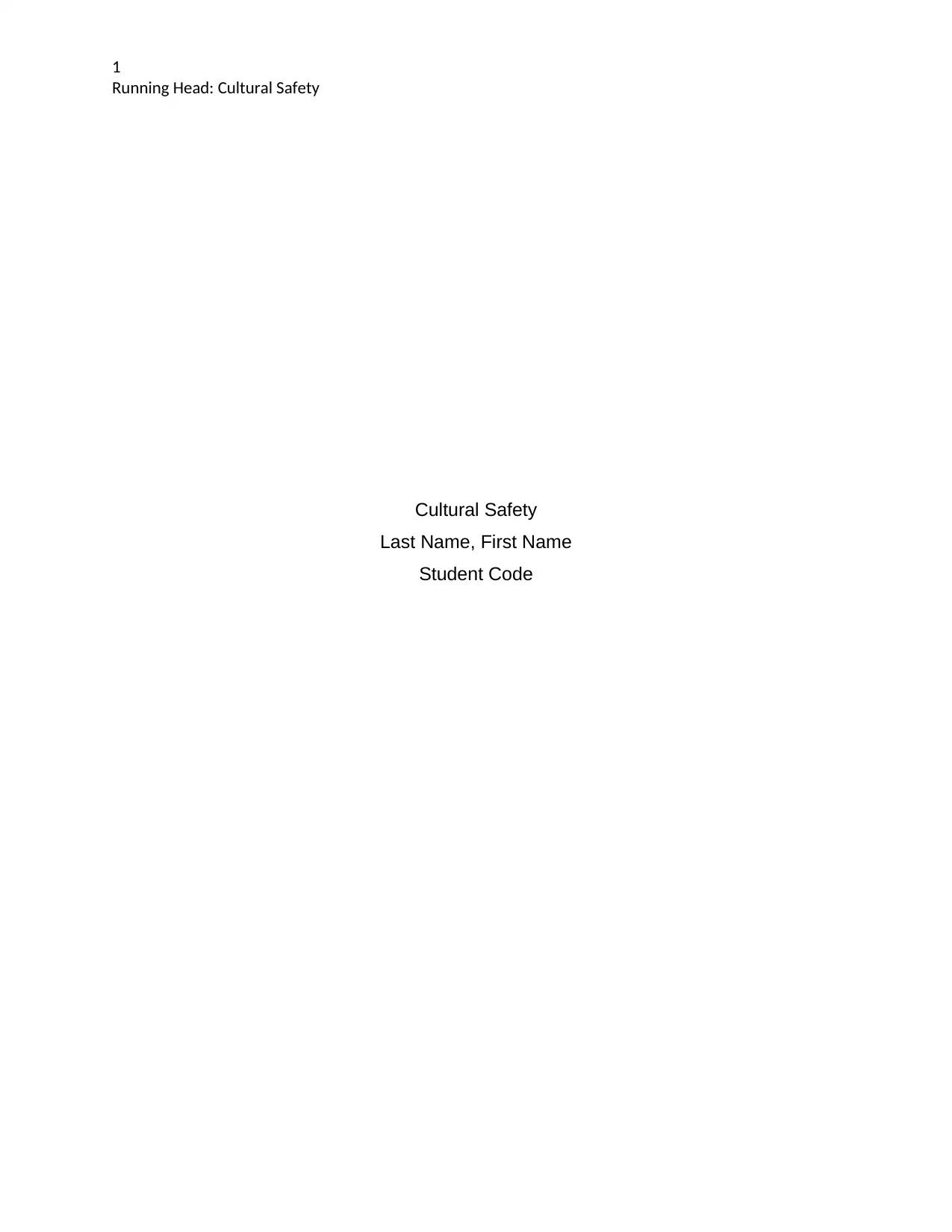
1
Running Head: Cultural Safety
Cultural Safety
Last Name, First Name
Student Code
Running Head: Cultural Safety
Cultural Safety
Last Name, First Name
Student Code
Paraphrase This Document
Need a fresh take? Get an instant paraphrase of this document with our AI Paraphraser
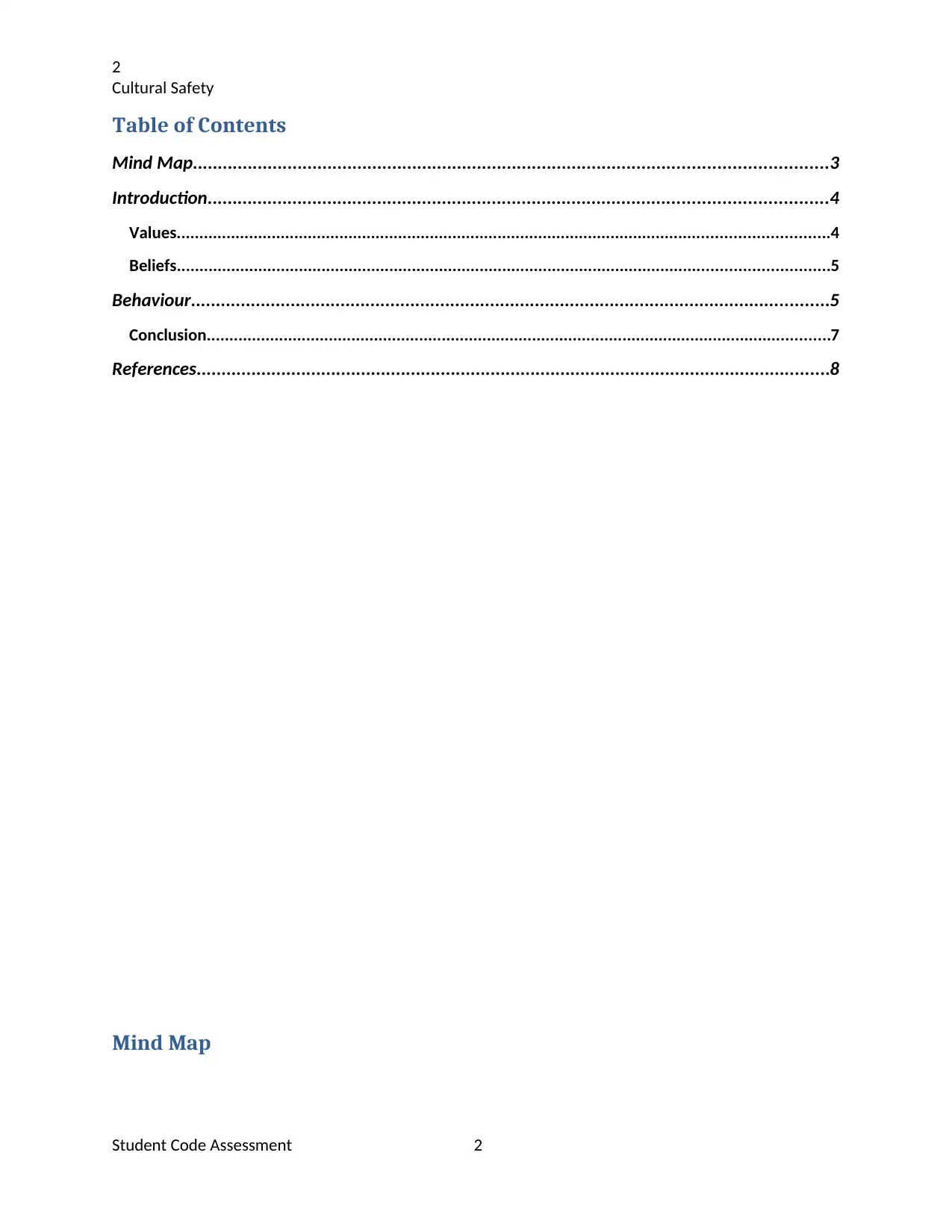
2
Cultural Safety
Table of Contents
Mind Map...............................................................................................................................3
Introduction............................................................................................................................4
Values................................................................................................................................................4
Beliefs................................................................................................................................................5
Behaviour................................................................................................................................5
Conclusion..........................................................................................................................................7
References...............................................................................................................................8
Mind Map
Student Code Assessment 2
Cultural Safety
Table of Contents
Mind Map...............................................................................................................................3
Introduction............................................................................................................................4
Values................................................................................................................................................4
Beliefs................................................................................................................................................5
Behaviour................................................................................................................................5
Conclusion..........................................................................................................................................7
References...............................................................................................................................8
Mind Map
Student Code Assessment 2
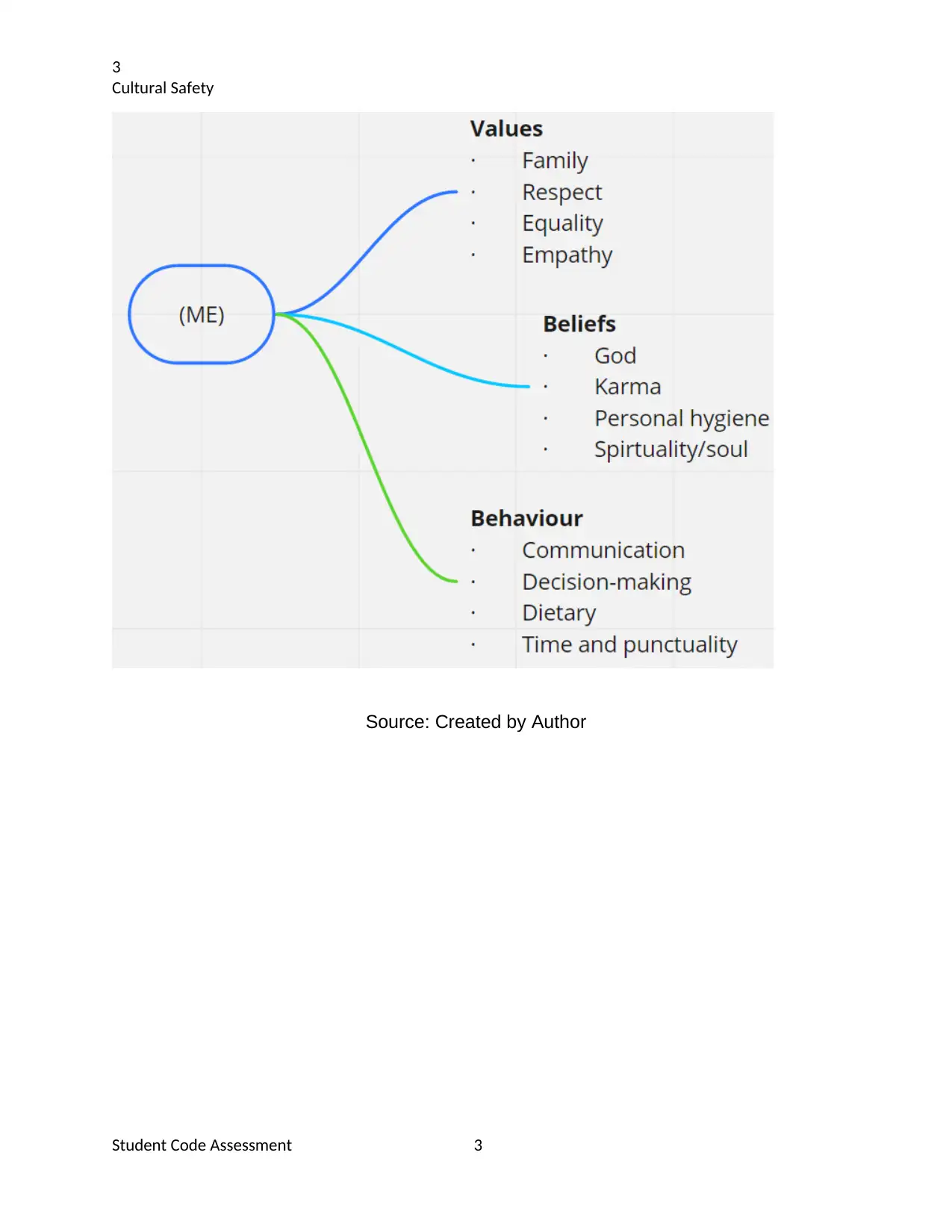
3
Cultural Safety
Source: Created by Author
Student Code Assessment 3
Cultural Safety
Source: Created by Author
Student Code Assessment 3
⊘ This is a preview!⊘
Do you want full access?
Subscribe today to unlock all pages.

Trusted by 1+ million students worldwide
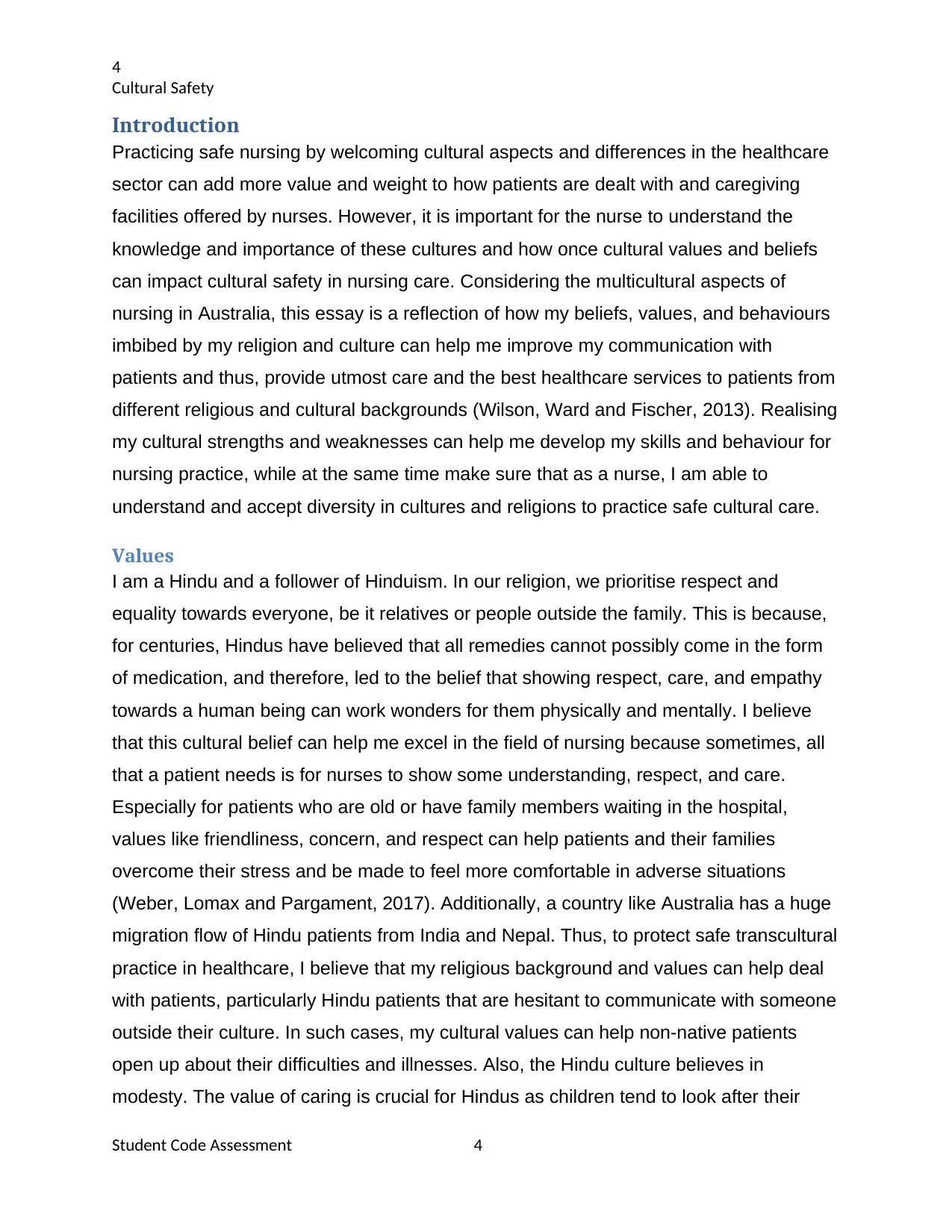
4
Cultural Safety
Introduction
Practicing safe nursing by welcoming cultural aspects and differences in the healthcare
sector can add more value and weight to how patients are dealt with and caregiving
facilities offered by nurses. However, it is important for the nurse to understand the
knowledge and importance of these cultures and how once cultural values and beliefs
can impact cultural safety in nursing care. Considering the multicultural aspects of
nursing in Australia, this essay is a reflection of how my beliefs, values, and behaviours
imbibed by my religion and culture can help me improve my communication with
patients and thus, provide utmost care and the best healthcare services to patients from
different religious and cultural backgrounds (Wilson, Ward and Fischer, 2013). Realising
my cultural strengths and weaknesses can help me develop my skills and behaviour for
nursing practice, while at the same time make sure that as a nurse, I am able to
understand and accept diversity in cultures and religions to practice safe cultural care.
Values
I am a Hindu and a follower of Hinduism. In our religion, we prioritise respect and
equality towards everyone, be it relatives or people outside the family. This is because,
for centuries, Hindus have believed that all remedies cannot possibly come in the form
of medication, and therefore, led to the belief that showing respect, care, and empathy
towards a human being can work wonders for them physically and mentally. I believe
that this cultural belief can help me excel in the field of nursing because sometimes, all
that a patient needs is for nurses to show some understanding, respect, and care.
Especially for patients who are old or have family members waiting in the hospital,
values like friendliness, concern, and respect can help patients and their families
overcome their stress and be made to feel more comfortable in adverse situations
(Weber, Lomax and Pargament, 2017). Additionally, a country like Australia has a huge
migration flow of Hindu patients from India and Nepal. Thus, to protect safe transcultural
practice in healthcare, I believe that my religious background and values can help deal
with patients, particularly Hindu patients that are hesitant to communicate with someone
outside their culture. In such cases, my cultural values can help non-native patients
open up about their difficulties and illnesses. Also, the Hindu culture believes in
modesty. The value of caring is crucial for Hindus as children tend to look after their
Student Code Assessment 4
Cultural Safety
Introduction
Practicing safe nursing by welcoming cultural aspects and differences in the healthcare
sector can add more value and weight to how patients are dealt with and caregiving
facilities offered by nurses. However, it is important for the nurse to understand the
knowledge and importance of these cultures and how once cultural values and beliefs
can impact cultural safety in nursing care. Considering the multicultural aspects of
nursing in Australia, this essay is a reflection of how my beliefs, values, and behaviours
imbibed by my religion and culture can help me improve my communication with
patients and thus, provide utmost care and the best healthcare services to patients from
different religious and cultural backgrounds (Wilson, Ward and Fischer, 2013). Realising
my cultural strengths and weaknesses can help me develop my skills and behaviour for
nursing practice, while at the same time make sure that as a nurse, I am able to
understand and accept diversity in cultures and religions to practice safe cultural care.
Values
I am a Hindu and a follower of Hinduism. In our religion, we prioritise respect and
equality towards everyone, be it relatives or people outside the family. This is because,
for centuries, Hindus have believed that all remedies cannot possibly come in the form
of medication, and therefore, led to the belief that showing respect, care, and empathy
towards a human being can work wonders for them physically and mentally. I believe
that this cultural belief can help me excel in the field of nursing because sometimes, all
that a patient needs is for nurses to show some understanding, respect, and care.
Especially for patients who are old or have family members waiting in the hospital,
values like friendliness, concern, and respect can help patients and their families
overcome their stress and be made to feel more comfortable in adverse situations
(Weber, Lomax and Pargament, 2017). Additionally, a country like Australia has a huge
migration flow of Hindu patients from India and Nepal. Thus, to protect safe transcultural
practice in healthcare, I believe that my religious background and values can help deal
with patients, particularly Hindu patients that are hesitant to communicate with someone
outside their culture. In such cases, my cultural values can help non-native patients
open up about their difficulties and illnesses. Also, the Hindu culture believes in
modesty. The value of caring is crucial for Hindus as children tend to look after their
Student Code Assessment 4
Paraphrase This Document
Need a fresh take? Get an instant paraphrase of this document with our AI Paraphraser
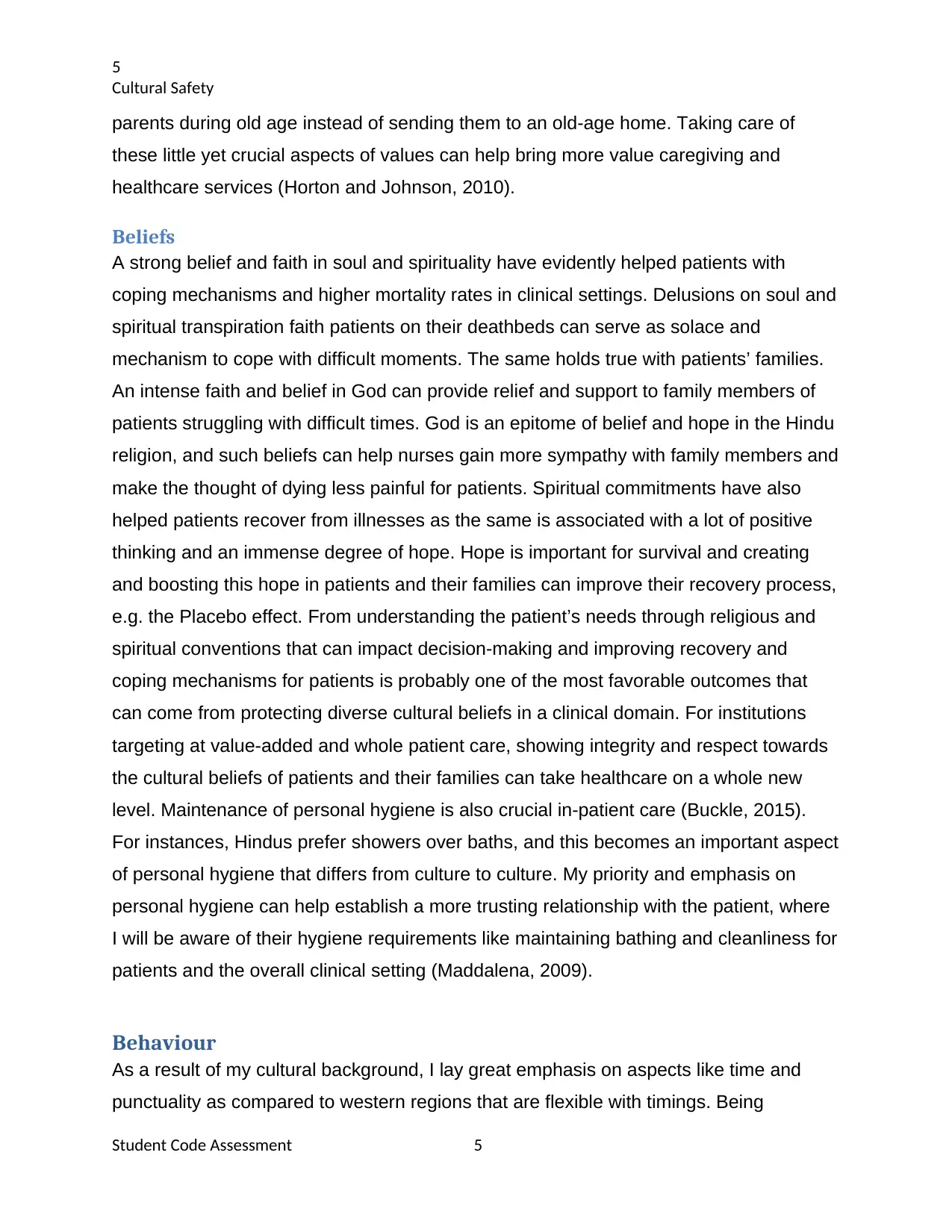
5
Cultural Safety
parents during old age instead of sending them to an old-age home. Taking care of
these little yet crucial aspects of values can help bring more value caregiving and
healthcare services (Horton and Johnson, 2010).
Beliefs
A strong belief and faith in soul and spirituality have evidently helped patients with
coping mechanisms and higher mortality rates in clinical settings. Delusions on soul and
spiritual transpiration faith patients on their deathbeds can serve as solace and
mechanism to cope with difficult moments. The same holds true with patients’ families.
An intense faith and belief in God can provide relief and support to family members of
patients struggling with difficult times. God is an epitome of belief and hope in the Hindu
religion, and such beliefs can help nurses gain more sympathy with family members and
make the thought of dying less painful for patients. Spiritual commitments have also
helped patients recover from illnesses as the same is associated with a lot of positive
thinking and an immense degree of hope. Hope is important for survival and creating
and boosting this hope in patients and their families can improve their recovery process,
e.g. the Placebo effect. From understanding the patient’s needs through religious and
spiritual conventions that can impact decision-making and improving recovery and
coping mechanisms for patients is probably one of the most favorable outcomes that
can come from protecting diverse cultural beliefs in a clinical domain. For institutions
targeting at value-added and whole patient care, showing integrity and respect towards
the cultural beliefs of patients and their families can take healthcare on a whole new
level. Maintenance of personal hygiene is also crucial in-patient care (Buckle, 2015).
For instances, Hindus prefer showers over baths, and this becomes an important aspect
of personal hygiene that differs from culture to culture. My priority and emphasis on
personal hygiene can help establish a more trusting relationship with the patient, where
I will be aware of their hygiene requirements like maintaining bathing and cleanliness for
patients and the overall clinical setting (Maddalena, 2009).
Behaviour
As a result of my cultural background, I lay great emphasis on aspects like time and
punctuality as compared to western regions that are flexible with timings. Being
Student Code Assessment 5
Cultural Safety
parents during old age instead of sending them to an old-age home. Taking care of
these little yet crucial aspects of values can help bring more value caregiving and
healthcare services (Horton and Johnson, 2010).
Beliefs
A strong belief and faith in soul and spirituality have evidently helped patients with
coping mechanisms and higher mortality rates in clinical settings. Delusions on soul and
spiritual transpiration faith patients on their deathbeds can serve as solace and
mechanism to cope with difficult moments. The same holds true with patients’ families.
An intense faith and belief in God can provide relief and support to family members of
patients struggling with difficult times. God is an epitome of belief and hope in the Hindu
religion, and such beliefs can help nurses gain more sympathy with family members and
make the thought of dying less painful for patients. Spiritual commitments have also
helped patients recover from illnesses as the same is associated with a lot of positive
thinking and an immense degree of hope. Hope is important for survival and creating
and boosting this hope in patients and their families can improve their recovery process,
e.g. the Placebo effect. From understanding the patient’s needs through religious and
spiritual conventions that can impact decision-making and improving recovery and
coping mechanisms for patients is probably one of the most favorable outcomes that
can come from protecting diverse cultural beliefs in a clinical domain. For institutions
targeting at value-added and whole patient care, showing integrity and respect towards
the cultural beliefs of patients and their families can take healthcare on a whole new
level. Maintenance of personal hygiene is also crucial in-patient care (Buckle, 2015).
For instances, Hindus prefer showers over baths, and this becomes an important aspect
of personal hygiene that differs from culture to culture. My priority and emphasis on
personal hygiene can help establish a more trusting relationship with the patient, where
I will be aware of their hygiene requirements like maintaining bathing and cleanliness for
patients and the overall clinical setting (Maddalena, 2009).
Behaviour
As a result of my cultural background, I lay great emphasis on aspects like time and
punctuality as compared to western regions that are flexible with timings. Being
Student Code Assessment 5
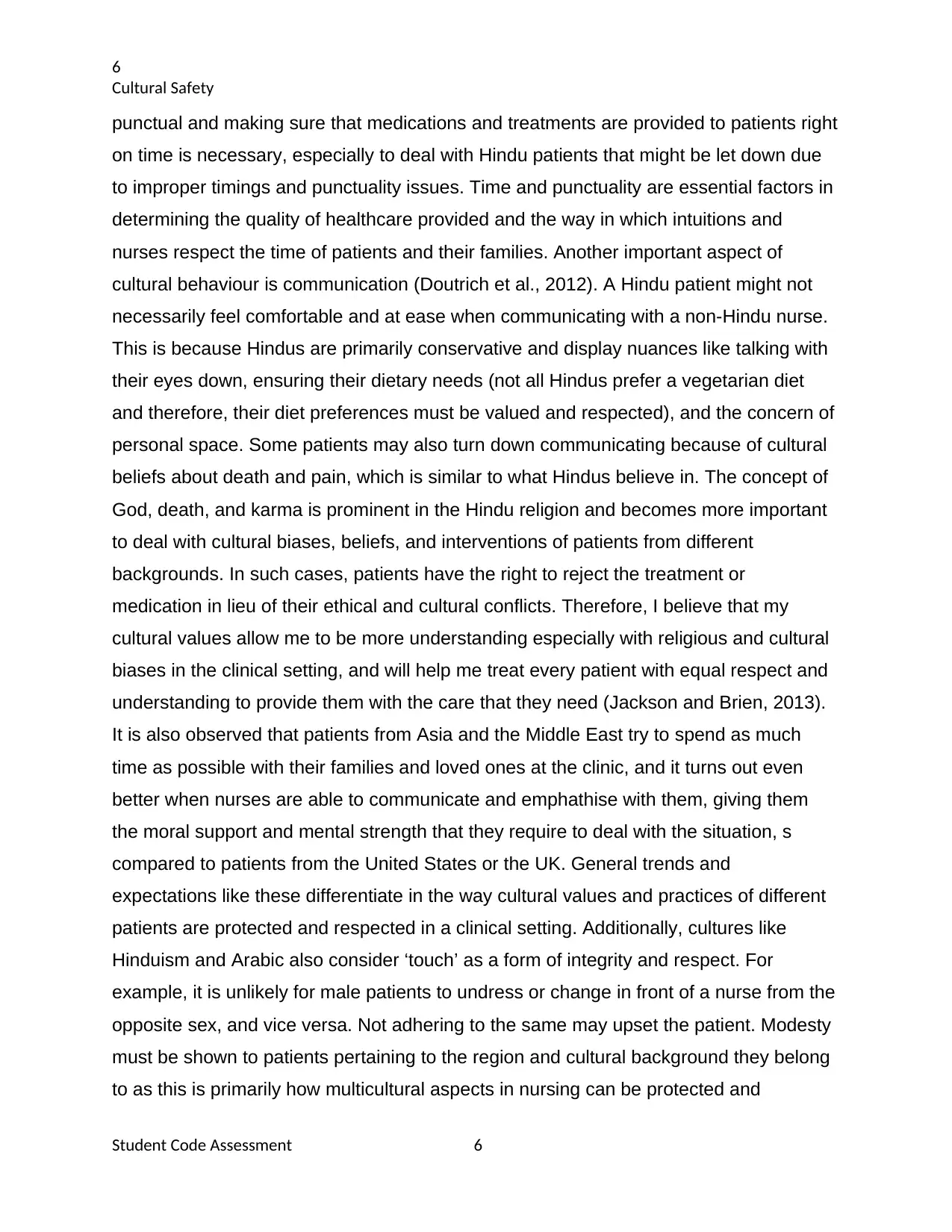
6
Cultural Safety
punctual and making sure that medications and treatments are provided to patients right
on time is necessary, especially to deal with Hindu patients that might be let down due
to improper timings and punctuality issues. Time and punctuality are essential factors in
determining the quality of healthcare provided and the way in which intuitions and
nurses respect the time of patients and their families. Another important aspect of
cultural behaviour is communication (Doutrich et al., 2012). A Hindu patient might not
necessarily feel comfortable and at ease when communicating with a non-Hindu nurse.
This is because Hindus are primarily conservative and display nuances like talking with
their eyes down, ensuring their dietary needs (not all Hindus prefer a vegetarian diet
and therefore, their diet preferences must be valued and respected), and the concern of
personal space. Some patients may also turn down communicating because of cultural
beliefs about death and pain, which is similar to what Hindus believe in. The concept of
God, death, and karma is prominent in the Hindu religion and becomes more important
to deal with cultural biases, beliefs, and interventions of patients from different
backgrounds. In such cases, patients have the right to reject the treatment or
medication in lieu of their ethical and cultural conflicts. Therefore, I believe that my
cultural values allow me to be more understanding especially with religious and cultural
biases in the clinical setting, and will help me treat every patient with equal respect and
understanding to provide them with the care that they need (Jackson and Brien, 2013).
It is also observed that patients from Asia and the Middle East try to spend as much
time as possible with their families and loved ones at the clinic, and it turns out even
better when nurses are able to communicate and emphathise with them, giving them
the moral support and mental strength that they require to deal with the situation, s
compared to patients from the United States or the UK. General trends and
expectations like these differentiate in the way cultural values and practices of different
patients are protected and respected in a clinical setting. Additionally, cultures like
Hinduism and Arabic also consider ‘touch’ as a form of integrity and respect. For
example, it is unlikely for male patients to undress or change in front of a nurse from the
opposite sex, and vice versa. Not adhering to the same may upset the patient. Modesty
must be shown to patients pertaining to the region and cultural background they belong
to as this is primarily how multicultural aspects in nursing can be protected and
Student Code Assessment 6
Cultural Safety
punctual and making sure that medications and treatments are provided to patients right
on time is necessary, especially to deal with Hindu patients that might be let down due
to improper timings and punctuality issues. Time and punctuality are essential factors in
determining the quality of healthcare provided and the way in which intuitions and
nurses respect the time of patients and their families. Another important aspect of
cultural behaviour is communication (Doutrich et al., 2012). A Hindu patient might not
necessarily feel comfortable and at ease when communicating with a non-Hindu nurse.
This is because Hindus are primarily conservative and display nuances like talking with
their eyes down, ensuring their dietary needs (not all Hindus prefer a vegetarian diet
and therefore, their diet preferences must be valued and respected), and the concern of
personal space. Some patients may also turn down communicating because of cultural
beliefs about death and pain, which is similar to what Hindus believe in. The concept of
God, death, and karma is prominent in the Hindu religion and becomes more important
to deal with cultural biases, beliefs, and interventions of patients from different
backgrounds. In such cases, patients have the right to reject the treatment or
medication in lieu of their ethical and cultural conflicts. Therefore, I believe that my
cultural values allow me to be more understanding especially with religious and cultural
biases in the clinical setting, and will help me treat every patient with equal respect and
understanding to provide them with the care that they need (Jackson and Brien, 2013).
It is also observed that patients from Asia and the Middle East try to spend as much
time as possible with their families and loved ones at the clinic, and it turns out even
better when nurses are able to communicate and emphathise with them, giving them
the moral support and mental strength that they require to deal with the situation, s
compared to patients from the United States or the UK. General trends and
expectations like these differentiate in the way cultural values and practices of different
patients are protected and respected in a clinical setting. Additionally, cultures like
Hinduism and Arabic also consider ‘touch’ as a form of integrity and respect. For
example, it is unlikely for male patients to undress or change in front of a nurse from the
opposite sex, and vice versa. Not adhering to the same may upset the patient. Modesty
must be shown to patients pertaining to the region and cultural background they belong
to as this is primarily how multicultural aspects in nursing can be protected and
Student Code Assessment 6
⊘ This is a preview!⊘
Do you want full access?
Subscribe today to unlock all pages.

Trusted by 1+ million students worldwide
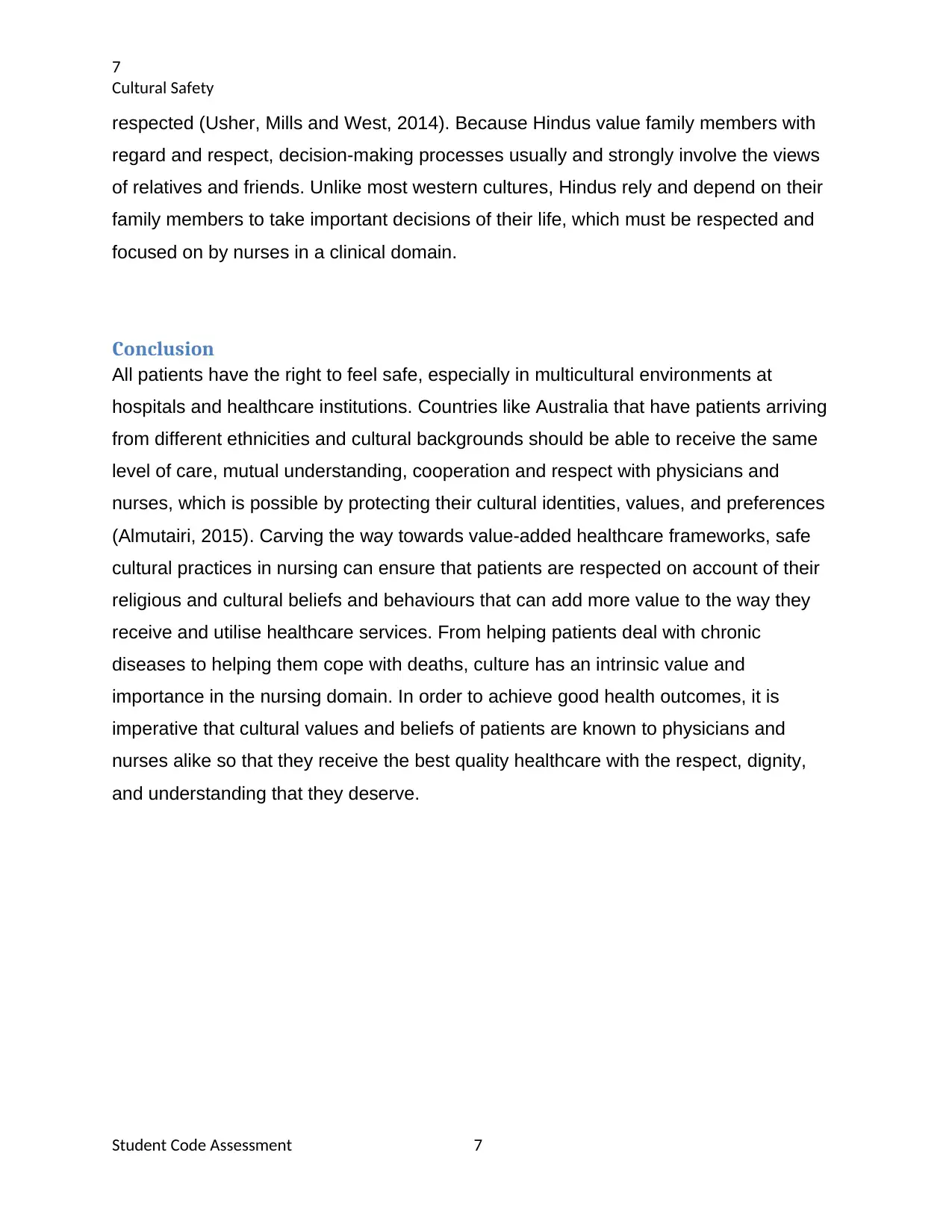
7
Cultural Safety
respected (Usher, Mills and West, 2014). Because Hindus value family members with
regard and respect, decision-making processes usually and strongly involve the views
of relatives and friends. Unlike most western cultures, Hindus rely and depend on their
family members to take important decisions of their life, which must be respected and
focused on by nurses in a clinical domain.
Conclusion
All patients have the right to feel safe, especially in multicultural environments at
hospitals and healthcare institutions. Countries like Australia that have patients arriving
from different ethnicities and cultural backgrounds should be able to receive the same
level of care, mutual understanding, cooperation and respect with physicians and
nurses, which is possible by protecting their cultural identities, values, and preferences
(Almutairi, 2015). Carving the way towards value-added healthcare frameworks, safe
cultural practices in nursing can ensure that patients are respected on account of their
religious and cultural beliefs and behaviours that can add more value to the way they
receive and utilise healthcare services. From helping patients deal with chronic
diseases to helping them cope with deaths, culture has an intrinsic value and
importance in the nursing domain. In order to achieve good health outcomes, it is
imperative that cultural values and beliefs of patients are known to physicians and
nurses alike so that they receive the best quality healthcare with the respect, dignity,
and understanding that they deserve.
Student Code Assessment 7
Cultural Safety
respected (Usher, Mills and West, 2014). Because Hindus value family members with
regard and respect, decision-making processes usually and strongly involve the views
of relatives and friends. Unlike most western cultures, Hindus rely and depend on their
family members to take important decisions of their life, which must be respected and
focused on by nurses in a clinical domain.
Conclusion
All patients have the right to feel safe, especially in multicultural environments at
hospitals and healthcare institutions. Countries like Australia that have patients arriving
from different ethnicities and cultural backgrounds should be able to receive the same
level of care, mutual understanding, cooperation and respect with physicians and
nurses, which is possible by protecting their cultural identities, values, and preferences
(Almutairi, 2015). Carving the way towards value-added healthcare frameworks, safe
cultural practices in nursing can ensure that patients are respected on account of their
religious and cultural beliefs and behaviours that can add more value to the way they
receive and utilise healthcare services. From helping patients deal with chronic
diseases to helping them cope with deaths, culture has an intrinsic value and
importance in the nursing domain. In order to achieve good health outcomes, it is
imperative that cultural values and beliefs of patients are known to physicians and
nurses alike so that they receive the best quality healthcare with the respect, dignity,
and understanding that they deserve.
Student Code Assessment 7
Paraphrase This Document
Need a fresh take? Get an instant paraphrase of this document with our AI Paraphraser
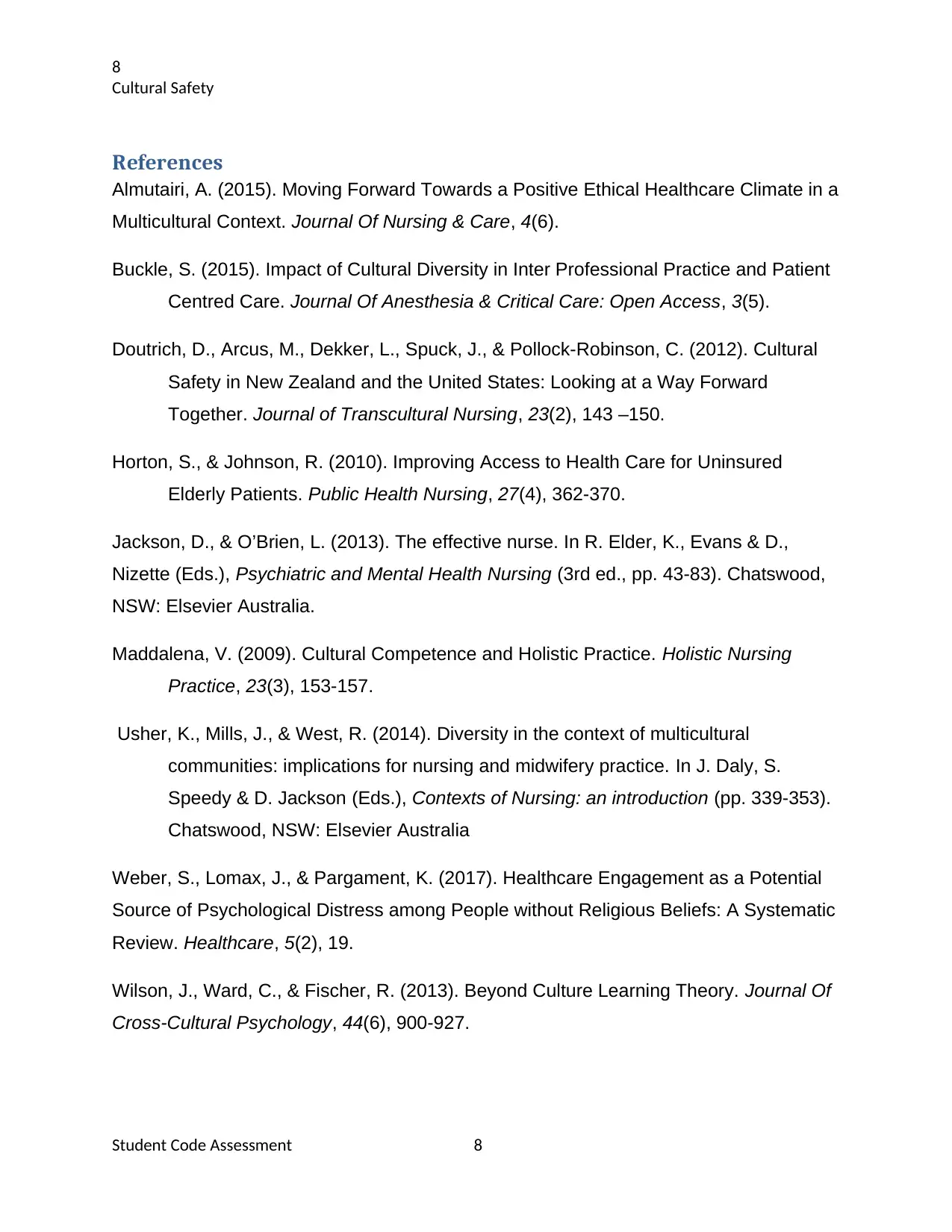
8
Cultural Safety
References
Almutairi, A. (2015). Moving Forward Towards a Positive Ethical Healthcare Climate in a
Multicultural Context. Journal Of Nursing & Care, 4(6).
Buckle, S. (2015). Impact of Cultural Diversity in Inter Professional Practice and Patient
Centred Care. Journal Of Anesthesia & Critical Care: Open Access, 3(5).
Doutrich, D., Arcus, M., Dekker, L., Spuck, J., & Pollock-Robinson, C. (2012). Cultural
Safety in New Zealand and the United States: Looking at a Way Forward
Together. Journal of Transcultural Nursing, 23(2), 143 –150.
Horton, S., & Johnson, R. (2010). Improving Access to Health Care for Uninsured
Elderly Patients. Public Health Nursing, 27(4), 362-370.
Jackson, D., & O’Brien, L. (2013). The effective nurse. In R. Elder, K., Evans & D.,
Nizette (Eds.), Psychiatric and Mental Health Nursing (3rd ed., pp. 43-83). Chatswood,
NSW: Elsevier Australia.
Maddalena, V. (2009). Cultural Competence and Holistic Practice. Holistic Nursing
Practice, 23(3), 153-157.
Usher, K., Mills, J., & West, R. (2014). Diversity in the context of multicultural
communities: implications for nursing and midwifery practice. In J. Daly, S.
Speedy & D. Jackson (Eds.), Contexts of Nursing: an introduction (pp. 339-353).
Chatswood, NSW: Elsevier Australia
Weber, S., Lomax, J., & Pargament, K. (2017). Healthcare Engagement as a Potential
Source of Psychological Distress among People without Religious Beliefs: A Systematic
Review. Healthcare, 5(2), 19.
Wilson, J., Ward, C., & Fischer, R. (2013). Beyond Culture Learning Theory. Journal Of
Cross-Cultural Psychology, 44(6), 900-927.
Student Code Assessment 8
Cultural Safety
References
Almutairi, A. (2015). Moving Forward Towards a Positive Ethical Healthcare Climate in a
Multicultural Context. Journal Of Nursing & Care, 4(6).
Buckle, S. (2015). Impact of Cultural Diversity in Inter Professional Practice and Patient
Centred Care. Journal Of Anesthesia & Critical Care: Open Access, 3(5).
Doutrich, D., Arcus, M., Dekker, L., Spuck, J., & Pollock-Robinson, C. (2012). Cultural
Safety in New Zealand and the United States: Looking at a Way Forward
Together. Journal of Transcultural Nursing, 23(2), 143 –150.
Horton, S., & Johnson, R. (2010). Improving Access to Health Care for Uninsured
Elderly Patients. Public Health Nursing, 27(4), 362-370.
Jackson, D., & O’Brien, L. (2013). The effective nurse. In R. Elder, K., Evans & D.,
Nizette (Eds.), Psychiatric and Mental Health Nursing (3rd ed., pp. 43-83). Chatswood,
NSW: Elsevier Australia.
Maddalena, V. (2009). Cultural Competence and Holistic Practice. Holistic Nursing
Practice, 23(3), 153-157.
Usher, K., Mills, J., & West, R. (2014). Diversity in the context of multicultural
communities: implications for nursing and midwifery practice. In J. Daly, S.
Speedy & D. Jackson (Eds.), Contexts of Nursing: an introduction (pp. 339-353).
Chatswood, NSW: Elsevier Australia
Weber, S., Lomax, J., & Pargament, K. (2017). Healthcare Engagement as a Potential
Source of Psychological Distress among People without Religious Beliefs: A Systematic
Review. Healthcare, 5(2), 19.
Wilson, J., Ward, C., & Fischer, R. (2013). Beyond Culture Learning Theory. Journal Of
Cross-Cultural Psychology, 44(6), 900-927.
Student Code Assessment 8
1 out of 8
Related Documents
Your All-in-One AI-Powered Toolkit for Academic Success.
+13062052269
info@desklib.com
Available 24*7 on WhatsApp / Email
![[object Object]](/_next/static/media/star-bottom.7253800d.svg)
Unlock your academic potential
Copyright © 2020–2025 A2Z Services. All Rights Reserved. Developed and managed by ZUCOL.





